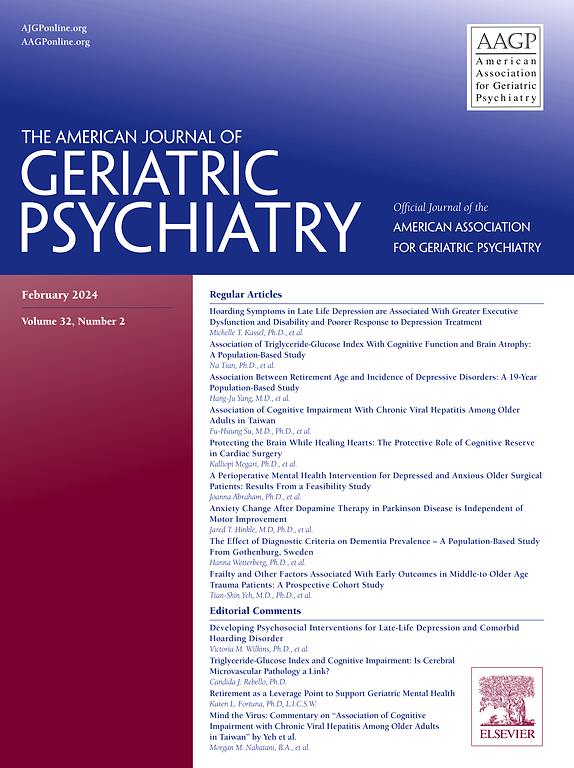厘清精神抑郁、紧张症、神经认知障碍和谵妄的诊断:多学科方法
摘要
模糊不清的临床表现会造成诊断上的不确定性,导致有效干预的延误,并增加不良临床结果的可能性。不幸的是,许多精神疾病的临床症状相互重叠。精神病性抑郁症、紧张性精神分裂症、神经认知障碍和谵妄都是症状重叠的不同临床症状的例子,而且都需要截然不同的治疗干预。虽然有许多文献专门论述了这些临床症状的诊断标准和处理方法,但很少有文献专门论述在面对复杂的临床表现时如何将这些诊断区分开来的难题。我们在此介绍一位 77 岁男性复杂精神科住院病人的情况,他就是这一诊断难题的典型代表。他主要表现为严重的情绪低落和功能减退,一天中大部分时间都躺在床上,几乎不注意基本卫生和口腔摄入。虽然最近的外部住院记录显示他曾被诊断为紧张性精神障碍,但他与医疗服务提供者的接触程度一般,而且有前列腺癌扩散的躯体妄想,这表明他可能被诊断为精神病性抑郁症。然而,在得出诊断结论之前,其他临床特征也浮出了水面。神经抑制剂的敏感性引起了临床医生对潜在的神经认知障碍(如路易体痴呆)的怀疑,于是向神经心理学服务部门进行了咨询。虽然不能完全排除痴呆症,但他们建议进行额外检查,以排除单纯疱疹性脑炎、自身免疫性肢端脑炎和副肿瘤综合征。在核磁共振成像显示中度微血管缺血性病变后,患者接受了真正的多学科治疗,神经内科也接受了会诊,以帮助缩小鉴别范围。脑电图无异常,血清脑炎检查也无异常。停用奥氮平后,帕金森症和认知能力明显改善,但严重的神经运动症状以及躯体妄想和虚无主义妄想依然存在。虽然抗精神病药物在临床上仍然适用于具有精神病特征的疑似抑郁症患者,但由于已确定的神经抑制剂敏感性、微妙的紧张性特征以及神经抑制剂恶性综合征的相关风险,患者仍需谨慎用药。最终,医生开始使用小剂量喹硫平,并取得了一些疗效;然而,他仍然保持着急性抑郁和孤僻,并伴有明显的消极情绪。为避免谵妄的潜在风险,在使用苯二氮卓类药物治疗这些紧张性特征时也采取了谨慎的态度。随着时间的推移,精神药物干预和药物试验的多学科方法使团队得出了一个主要诊断,即重度抑郁障碍伴精神病特征和微妙的紧张性障碍。住院初期观察到的突变被确定与奥氮平诱发的抗胆碱能谵妄有关。有了更明确的诊断结果,治疗小组就可以向患者和家属说明进行电休克治疗(ECT)的重要性。在确定是否适合接受电休克疗法时,考虑了患者的心血管风险因素和已知的微血管病变。在开始接受电休克疗法治疗后,他的病情立即得到了客观改善,在接受第五次治疗后,他的抑郁和功能得到了显著改善,并报告称躯体妄想几乎消失,因此被认为适合出院。他在门诊完成了电痉挛疗法,随访显示他的情绪、功能和生活质量都得到了持久改善,并继续享受与家人社交和打网球的积极生活方式。我们通过这个病例进一步探讨了精神抑郁、紧张症、神经认知障碍和谵妄之间的症状相似性所带来的临床挑战,并讨论了在表现复杂且不明确的情况下的最佳治疗方法。An ambiguous clinical presentation can create diagnostic uncertainty, leading to delays in effective interventions and increasing the likelihood of adverse clinical outcomes. Unfortunately, many psychiatric conditions share overlapping clinical symptoms. Psychotic depression, catatonia, neurocognitive disorders, and delirium are all examples of distinct clinical conditions with overlapping symptomatology, and all require decidedly different therapeutic interventions. While much literature is devoted to the diagnostic criteria and management of these clinical conditions, little is dedicated to the challenge of disentangling these diagnoses when faced with a complex clinical presentation.
We present here a complicated psychiatric inpatient hospitalization of a 77-year-old male who exemplified this diagnostic challenge. He primarily presented with severely depressed mood and decreased functionality, remaining in bed for much of the day with little attention to basic hygiene and oral intake. While records from a recent outside hospitalization carried a historical diagnosis of catatonia, his moderate level of engagement with providers and somatic delusion of disseminated prostate cancer suggested an alternate diagnosis of psychotic depression. However, before a diagnostic conclusion could be reached, other clinical characteristics surfaced. Following a singular administration of olanzapine shortly after his initial assessment, he developed Lilliputian hallucinations, prominent parkinsonism, and significantly altered mentation.
Neuroleptic sensitivity raised clinical suspicion for an underlying neurocognitive disorder such as dementia with Lewy bodies, and a consult was placed to the neuropsychology service. While dementia could not be fully ruled out, they did recommend additional workup to rule out herpes simplex encephalitis, autoimmune limbic encephalitis, and paraneoplastic syndromes. After his MRI imaging revealed moderate microvascular ischemic changes, a true multidisciplinary approach to care was taken, as neurology was consulted to also help narrow the differential. An EEG was unremarkable and a serum encephalitis panel was also unremarkable. Olanzapine was discontinued with significant improvement in parkinsonism and cognition; however, severe neurovegetative symptoms and somatic and nihilistic delusions persisted. While antipsychotics remained clinically indicated for a suspected depression with psychotic features, caution was taken due to established neuroleptic sensitivity, subtle catatonic features, and the related risks of neuroleptic malignant syndrome. Ultimately, low-dose quetiapine was initiated with some benefit; however, he continued to remain acutely depressed and withdrawn with prominent negativism. Trials with benzodiazepines for these catatonic features were also approached with caution to avoid potential risks of delirium.
Over time, a multidisciplinary approach to psychopharmacologic interventions and medication trials led the team to a principal diagnosis of major depressive disorder with psychotic features and subtle catatonia. The abrupt changes observed early in the hospital course were determined to be related to olanzapine-induced anticholinergic delirium. With greater diagnostic certainty, the team was able to counsel the patient and family about the importance of pursuing electroconvulsive therapy (ECT). The patient's cardiovascular risk factors and known microvascular changes were considered in the determination of the appropriateness for ECT. After starting ECT, he was immediately noted to have objective improvement, and following his fifth treatment, he was deemed appropriate for discharge after exhibiting significant improvement in depression and functionality and reporting near-resolution of somatic delusions. He was able to complete ECT on an outpatient basis and follow-up visits note durable improvements in mood, functionality, and quality of life, continuing to enjoy an active lifestyle of socializing with family and playing tennis. We use this case to further explore the clinical challenges that stem from the symptomatic similarity between psychotic depression, catatonia, neurocognitive disorders, and delirium and discuss optimal therapeutic approaches when the presentation appears complex and equivocal.

 求助内容:
求助内容: 应助结果提醒方式:
应助结果提醒方式:


